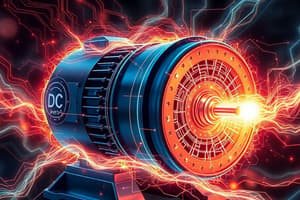Podcast
Questions and Answers
What is the main principle behind Permanent Magnet DC Motors?
What is the main principle behind Permanent Magnet DC Motors?
Permanent magnets create magnetic fields to drive the rotor
Explain how Armature-controlled DC Motors operate.
Explain how Armature-controlled DC Motors operate.
The rotor and stator have coils of wire that can be energized by passing current through them, controlling the motor's rotation.
What are the advantages of Armature-controlled DC Motors over AC motors?
What are the advantages of Armature-controlled DC Motors over AC motors?
Better controllability, simplicity, efficiency, and quiet operation
In which applications are Permanent Magnet DC Motors commonly used?
In which applications are Permanent Magnet DC Motors commonly used?
Name three examples of Armature-controlled DC Motors.
Name three examples of Armature-controlled DC Motors.
What is the function of an ELCB in electrical systems?
What is the function of an ELCB in electrical systems?
What is the function of an Earth Leakage Circuit Breaker (ELCB)?
What is the function of an Earth Leakage Circuit Breaker (ELCB)?
How does an ELCB operate to prevent electrical hazards?
How does an ELCB operate to prevent electrical hazards?
What is unique about the Universal Motor in terms of power sources?
What is unique about the Universal Motor in terms of power sources?
How can the direction of rotation of a Universal Motor be determined?
How can the direction of rotation of a Universal Motor be determined?
If a universal motor's nameplate indicates a winding with a positive terminal connected to the rotor end plate, in which direction will the motor run when connected to DC power?
If a universal motor's nameplate indicates a winding with a positive terminal connected to the rotor end plate, in which direction will the motor run when connected to DC power?
Why is understanding components like DC motors and ELCBs important in electrical applications?
Why is understanding components like DC motors and ELCBs important in electrical applications?
Flashcards are hidden until you start studying
Study Notes
Electrical Engineering
Electrical engineering is a field of engineering that deals with the study and application of electricity, electronics, and electromagnetism. It involves designing, developing, testing, and implementing electrical systems and electronic devices. Below are some interesting aspects related to the topic of electrical engineering:
Types of DC Motors and Applications
DC motors are crucial components in many industrial and commercial applications. They have different types based on their construction materials and operational principles. Some common types include:
Permanent Magnet DC Motor
Permanent magnet DC motors rely on permanent magnets to create magnetic fields that drive the rotor. These motors are simple, efficient, and cost-effective, making them suitable for various applications such as appliances, drills, fans, and automotive windshield wipers.
Armature-controlled DC Motor
In these motors, the rotor and stator have coils of wire that can be energized by passing current through them. By controlling the direction and speed of the current, you control the rotation of the motor. Examples of armature-controlled DC motors include shunt wound, series wound, and compound wound motors.
Applications of these DC motors include industrial machinery, robotics, vehicles, and handheld power tools like drills and saws. They offer advantages over AC motors due to better controllability, simplicity, efficiency, and quiet operation.
Function of ELCB
An earth leakage circuit breaker (ELCB) is a protective device specifically designed to protect humans from electric shock caused by electrical faults. It operates on the principle of detecting changes in the ground line potential, during which it will disconnect the power source from the grounding system.
The ELCB is essential in preventing electrical hazards and ensuring safety in residential, commercial, and industrial settings. It provides protection against electrical faults, such as earth leakage, by detecting and interrupting the flow of current in case of a short circuit or earth leakage.
Direction of Rotation of Universal Motor
Universal motors are unique in their ability to run on both AC and DC power sources. They achieve this by using a rotor with a permanent magnet and a stator with a rotor winding. The motor is designed to run in a specific direction under DC power and in the opposite direction when connected to AC power.
The direction of rotation of a universal motor can be determined by the direction of the rotor winding, which is usually indicated on the motor's nameplate. For example, if the nameplate shows a winding with a positive terminal connected to the rotor end plate, the motor will run clockwise when connected to DC power.
In summary, electrical engineering plays a vital role in designing and implementing systems that use electricity to perform work. From DC motors to earth leakage circuit breakers, understanding these components helps ensure safety and efficiency in electrical applications.
Studying That Suits You
Use AI to generate personalized quizzes and flashcards to suit your learning preferences.




